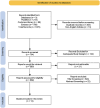Adjustment Disorders and Quality of Life in Patients With Tracheostomy and Tracheal Cannula: A Scoping Review
- PMID: 40432349
- PMCID: PMC12117200
- DOI: 10.1002/brb3.70517
Adjustment Disorders and Quality of Life in Patients With Tracheostomy and Tracheal Cannula: A Scoping Review
Abstract
Introduction: Tracheostomy (TCT) surgery and subsequent tracheal cannula (TC) insertion involve several physical, communicative, and psychological changes for the patient. Decreased mood and dysfunctional states such as morbid anxiety, depression, and stress are often experienced in these clinical situations, and affect the quality of life (QoL) and the rehabilitation process. This review aims to examine the studies in the literature on adjustment disorders (AjD) in patients with TCT or TC and how this affects their QoL during the rehabilitation process.
Methods: Studies were identified from an online search of PubMed, Cochrane Library, and Embase databases. Studies published between 2013-2023 were selected. This review has been registered on OSF (n): DOI 10.17605/OSF.IO/RHX3J.
Results: TCT patients were found to experience AjD in terms of anxiety, depression, and stress, which may have a significant impact on QoL and the recovery/extubation time during long-term rehabilitation.
Conclusions: The AjD must be considered seriously and carefully during the rehabilitation process in tracheostomized patients, as it can have significant repercussions on the QoL and caregivers. The rehabilitation path must consider the problems linked to this condition: physical, communicative, and psychological.
Keywords: anxiety; depression; quality of life; rehabilitation; stress; tracheostomy.
© 2025 The Author(s). Brain and Behavior published by Wiley Periodicals LLC.
Conflict of interest statement
The authors declare no conflicts of interest.
Figures
References
-
- Ayers, M. E. 1999. “Assessing and Treating Open Head Trauma, Coma, and Stroke Using Real‐Time Digital EEG Neurofeedback.” In Introduction to Quantitative EEG and Neurofeedback: 203–222.
-
- Bachem, R. , and Casey P. 2018. “Adjustment Disorder: A Diagnosis Whose Time Has Come.” Journal of Affective Disorders 227: 243–253. - PubMed
-
- Blecha, S. , Brandl M., Zeman F., et al. ; DACAPO Study Group . 2020. “Tracheostomy in Patients With Acute respiratory Distress Syndrome is Not Related to Quality of Life, Symptoms of Psychiatric Disorders or Return‐to‐Work: The Prospective DACAPO Cohort Study.” Annals of Intensive Care 10, no. 1: 52. 10.1186/s13613-020-00671-x. - DOI - PMC - PubMed
Publication types
MeSH terms
LinkOut - more resources
Full Text Sources


